The biggest headache for cross-border business owners: wanting one website to cover multiple markets, but afraid translated content will be flagged as spam by Google. Splitting into multiple sites? Just maintaining 3–5 local teams could eat up all your profits.
You’ve definitely seen competitors lazily use translation plugins—keyword rankings just don’t move. And you’ve probably heard of domain-savvy veterans who saw a 50% traffic spike from local domains… but burned through cash even faster.
This article skips the fluffy “global strategy” talk. We break down 27 real-life cases—using subdirectories for Japanese saved 47% in budget, but conversions were cut in half.
Perfect for rookie teams testing 3–5 languages with under ¥200K (~$28K) to spend.

Table of Contens
ToggleWhat’s the smartest way to split your SEO budget?
“Saving is earning” can be a trap in global e-commerce. Last year, a guy selling Bluetooth headsets tried to cut server costs by machine-translating his English site into 8 languages. Google flagged the whole thing as low quality, tanking his main site’s rankings.
On the flip side, a baby products brand invested in separate editors for Germany, France, and Spain—burned through ¥150K in ad spend in one month, but recovered that through organic traffic in 6 months.
The two main tradeoffs:
- Single-site setup: Save ¥20K–30K/year in hosting and maintenance, but Google might treat English and Indonesian pages as “duplicate content,” causing keyword cannibalization.
- Multi-site setup: Using local domains like .de/.fr boosts click-through rates by 10–15%, but each site needs its own content and link building team—double the labor costs.
How to make it work:
- Testing phase (first 3 months): Use subdirectories (/es/, /de/) for 3 languages. Spend ¥500/month on Ahrefs to track keyword movements.
- Expansion phase: If local search terms make up more than 30% of traffic (e.g., Mexican users searching “compra + product”), register a .com.mx domain ASAP.
- Golden rule: Always allocate 20% of your total budget for link building. You’re essentially buying “votes” for your domain.
Real-world lesson:
A tools site hosted English, Spanish, and Portuguese on the same domain. Brazilian users bounced at a rate of 82%. After switching to a separate domain, yearly costs rose by ¥12K, but conversion cost dropped from 4.7to1.9.
Takeaway: If your average order value in a market is over $200, don’t think twice—get a local domain.
Can you rely on translation plugins?
“Eight languages in five minutes” sounds like a dream. It could be your worst nightmare.
One seller used Google Translate to turn English product pages into Indonesian. A title saying “Waterproof and Dustproof” got turned into “Anti-tears and Anti-dirty air.” Locals were confused. Average time on page? 19 seconds.
But another seller used DeepL for the German version, then hired a Berlin student to make it sound local. He got the keyword for “power bank” ranked on page one of Google Germany.
The two main tradeoffs:
- Pure machine translation: Saves ¥50–80 per 1,000 words, but can mess up product specs (like turning “stainless steel” into “steel that won’t rust”). Google’s EEAT score takes a nosedive.
- Human polish: Costs ¥120 per 1,000 words in languages like Indonesian, but triples your reach on long-tail keywords—think “halal-certified phone case.”
How to get it right:
- Hybrid workflow: Draft English with ChatGPT → Translate via DeepL → Local student checks hot topics using CrowdTangle and adds 3 local references (like “Day of the Dead” deals for Mexico).
- Final QA: Always manually double-check prices and size units. One seller once mistranslated “$199” as “199 Vietnamese Dong,” losing ¥230 per sale.
- Prioritize smart: Use human translation for homepages and product pages. Use plugins + keyword tweaks (like swapping “how to” for “como hacer”) for blog and tech docs.
Real-world lesson:
A plus-size fashion store used plugins for the French version. “Stretch fabric” became “fabric like rubber bands.” Negative reviews spiked by 47%.
They started paying ¥3,000/month for a part-time editor in Lyon. Costs rose by 15%, but average order value jumped from €89 to €127.
Takeaway: Once a language version hits over 2.5% conversion rate from Google traffic, start human-optimizing.
.com or local domains?
“.com works everywhere” is basically a myth in cross-border ecom.
A guy selling hiking gear insisted on using a .com to crack the German market. Germans searching “wanderschuhe kaufen” (buy hiking boots) only saw .de domains on the first 3 pages. His .com site was nowhere to be found.
But a swimsuit seller bit the bullet and registered a .fr domain. It cost an extra ¥2,000/year, but their French organic traffic soared by 60%.
The two main tradeoffs:
- .com domain: Works globally, but lacks local trust. Brazilian shoppers seeing .com assume it’s a U.S. site—even perfect Portuguese won’t fix the 12% lower add-to-cart rate.
- Country-specific domains: Domains like .de or .mx get boosted in local search, but need legit business docs to register. In Japan, for example, you need to submit a “Certificate of Registered Matters”—just the notarization cost could fund a local editor.
Action plan: This is an HTML blog article. Please translate the content into English without changing the HTML structure. Keep it conversational and natural.
- 测试期骚操作:主站用.com,同时买下目标国的国别域名(比如.co.id)做301跳转,既保品牌又蹭本地SEO红利
- 穷鬼平替方案:重点市场用子域名(id.example.com),非重点市场用子目录(example.com/id/),用GSC的“国家定位”功能强行关联地域
- 隐藏雷区排查:提前查当地域名注册政策,比如越南规定.vn域名必须由本地公民持有,找代理注册每年多花500元但能绕过限制
教训:
某美容仪品牌用.com主攻韩国市场,结果Naver(韩国百度)压根不收录,后来换成.kr域名+韩元定价,三个月冲到品类词第一屏。
虽然每年多花1.5万养韩国服务器,但ROI从0.8飙到3.2。
记住:如果你的目标市场有本土搜索引擎(如俄罗斯Yandex),国别域名是入场门票。
穷有穷玩法
SEO行业有个残酷真相:80%的烧钱动作都在为认知偏差买单。
小企业想突围,得学会用游击战术——专挑巨头看不上的流量洼地,专打平台算法的认知盲区。
选对战场比努力更重要
- Google系国家优先收割:美国/菲律宾/新加坡市场,Google搜索占比超92%,避开Yandex(俄语区技术门槛高)、Naver(韩国需Kakao账号绑定)等封闭生态
- 冷门语言红利期:德语法语站月均维护成本¥3500,而印尼语/泰语本地团队报价低至¥1800(案例:某3C配件商用巴铁写手做乌尔都语测评,客诉率从12%降至4%)
- 时差攻击策略:针对南美市场(巴西/阿根廷),在北京时间凌晨2-6点集中更新内容,此时当地竞品运营团队普遍离线
关键词的”农村包围城市”打法
- 核心词让巨头内耗:英文主站死磕”wireless headphones”等红海词,用FAQ结构吃掉精选摘要(Featured Snippet)
- 长尾词本地化截流:西班牙语站专攻”audífonos inalámbricos para nadar”(游泳用无线耳机),葡萄牙语站做”fones de ouvido à prova de suor”(防汗耳机)
- 工具站薅流量公式:产品型号+国家限定词+解决方案(如”Galaxy Buds2 Pro Mexico firmware update fix”)
零成本制造”伪本地品牌”感
服务器地理定位戏法:墨西哥用户访问自动跳转.site.com.mx镜像站,实际服务器仍在阿里云香港(延迟控制在200ms内)
本地化内容三板斧:
- 用Google街景截图替代专业摄影(巴西用户更信餐厅实景图)
- 产品参数表嵌入当地计量单位(印度站显示毫米/摄氏度的同时保留英寸/华氏度对照)
- 评论区植入本土网红语录(日本站引用@Tokyo_gadgetman的推文截图)
社媒寄生术:在印尼TikTok用#TutorialHack标签发布产品另类用法,导流至WordPress站点的/campaign/过渡页
低预算外链建设方案(免费~12万预算)
- 政府/教育机构:墨西哥州政府官网(.gob.mx)、印度大学官网(.ac.in)允许投稿行业白皮书
- 本地黄页:越南的muare.vn、泰国的pantip.com论坛签名档留链接仍有效
- 付费外链:尽可能发布顶级域名下的文章外链(独立站外链)获取更多域名投票权(约50~150元/条)+大量群发Nofollow自然外链(约几千块发1万条)
付费注意踩坑点:不要做相关性外链,不要做高权重外链,前者有可能被谷歌判断作弊限制展现,后者量不足,单靠几条起不来,还有就是要收录,要收录,要收录。
不收录的外链,没有价值,谷歌不会自然收录,只有网站是自己的,才会有100%收录机会,或者使用爬虫池促进收录
从零到上排名的落地步骤
95%的新手死在“既要又要”的幻想里——既想快速覆盖所有语种,又试图在每个市场做到权威站水平。
启动期(0-30天)
技术选型反常识:
▸ 用WordPress+Polylang搭建多语言站(比Shopify省67%插件费用)
▸ 服务器选Cloudways的DigitalOcean机型(IP库含43国数据中心,规避谷歌地理定位误判)
内容冷启动:
- 用ChatGPT生成10篇”XX国家+产品痛点”综述(如”德国人为什么需要防冻耳机”)
- 本地写手负责插入真实数据(案例:墨西哥站添加「地铁票价从5比索涨到7比索导致通勤族更需要降噪耳机」)
- 用Canva制作当地节日营销图(巴西狂欢节前上线/carnaval专题页)
流量安全:这是一篇带HTML代码的博客文章,您需要对原文进行英文翻译,不要对内容结构(包括HTML代码)进行修改,只需要翻译就可以,尽量口语化
▸ Use Google Search Console to block keywords like “how to buy” or “coupon” (filter out deal hunters)
▸ Temporarily block price-sensitive pages in robots.txt (to avoid getting scraped by competitors)
5.2 Optimization Phase (Day 31–90)
Clean up low-quality content:
▸ In GA4, set a filter like “Bounce Rate > 75% and Time on Page < 35 seconds" to bulk noindex low-quality pages ▸ Cut language versions with a conversion rate under 1% (one tool site dropped Hungarian and saw a 41% drop in customer support costs)Localization upgrades:
Pay a 3.5% commission to local KOLs to record unboxing videos in regional dialects (Bisaya-language videos on the Philippines site boosted conversions by 11%)
Add local certification logos in product specs (adding a GS mark on the German site reduced return rates by 9%)
Configure your server to auto-redirect to holiday landing pages based on local public holidays (click-through rate on the Saudi site surged 27% during Ramadan)
Backlink strategy:
▸ Use HARO to get free backlinks from government and education sites like .edu.co/.gov.ph
▸ Hire people on Fiverr to report spammy backlinks of competitors (a headphone site took down 12 PBN links from a rival, tanking their rankings)
Expansion Phase (Day 91–180)
Independent site split decision:
│→ Local search traffic > 40% → register a country-specific domain (e.g., .com.mx)
│→ Avg. local session duration > 7 minutes → activate local CDN nodes
│→ Holiday traffic spike > 220% → launch a multilingual customer support system
Price discrimination hacks:
▸ Show “12-month interest-free installment” for Brazilian users (finance cost passed to local lenders)
▸ Display a “Green Discount” on the German site between 10 PM–6 AM (time-zone targeting to filter high-value users)
Create location-specific content:
Compare search behavior between “Mexico City vs Monterrey” using Google Trends
Develop dialect-specific FAQs for Hanoi and Ho Chi Minh City users in Vietnam
Embed a map of Jakarta offline service centers on the Indonesia site (users who clicked the map spent 53% more per order)
Still can’t decide between one site or multiple for SEO?
Then just ask yourself this: does your content actually help users?
If the answer is yes, then make the decision based on your budget.






